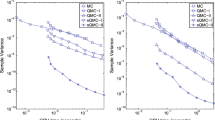Abstract.
We consider a new numerical method developed by Barraquand and Martineau for the pricing of American securities where the payoff depends on several sources of uncertainty. This method utilizes Monte Carlo simulation and is referred to as Stratified State Aggregation along the Payoff (SSAP). Since there are no other methods that so effectively reduce the dimensionality of high-dimensional problems, the SSAP method has generated significant interest. Numerical results are presented showing that, if a sufficiently large number of time steps are used, in the cases of the two-dimensional maximum and minimum options, SSAP typically prices to within 6 cents of the true price. However, we show that if the security depends on two or more sources of uncertainty, then the price obtained by the SSAP method will not, in general, converge to the correct theoretical price, due in large part to incorrect exercise decisions being made. We analyze the exercise regions in the cases of the two-dimensional maximum and minimum options and show how SSAP makes incorrect exercise decisions. Suggestions for improving SSAP pricing accuracy by choosing a partition other than the payoff are discussed.
Similar content being viewed by others
Explore related subjects
Discover the latest articles and news from researchers in related subjects, suggested using machine learning.Author information
Authors and Affiliations
Additional information
Received October 3, 1997; revised February 10, 1998.
Rights and permissions
About this article
Cite this article
Coyle, L., Yang, J. Analysis of the SSAP Method for the Numerical Valuation of High-Dimensional Multivariate American Securities. Algorithmica 25, 75–98 (1999). https://doi.org/10.1007/PL00009284
Issue Date:
DOI: https://doi.org/10.1007/PL00009284




